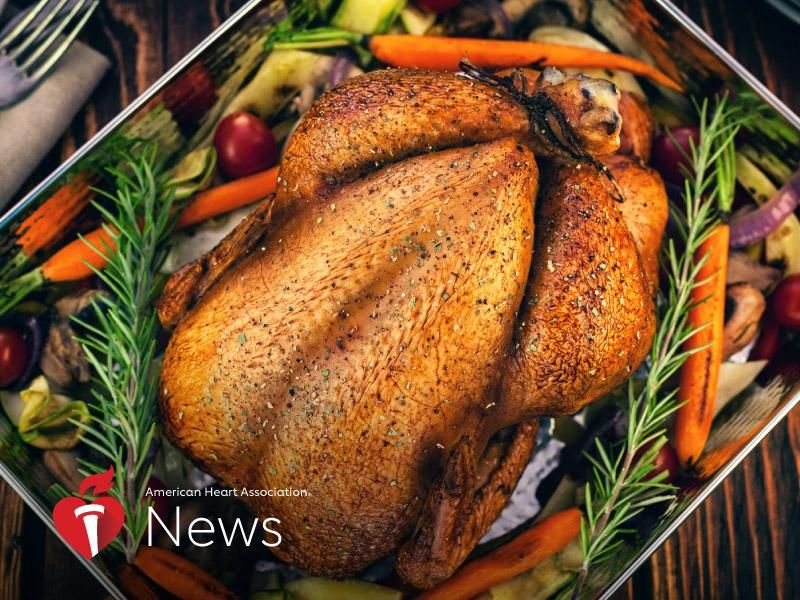
TUESDAY, Nov. 23, 2021 (American Heart Association News) — Since before Americans officially celebrated Thanksgiving, turkey has had a place at the holiday table. Lately, it also has developed a reputation as a relatively healthy part of the big meal.
Does it deserve that reputation?
“Yes, it does,” said Catherine M. Champagne, a professor of nutritional epidemiology and dietary assessment and nutrition counseling at Louisiana State University’s Pennington Biomedical Research Center in Baton Rouge. But that blessing comes with a side of caveats.
Historians say turkey has been part of American harvest feasts since the early 19th century, but a couple of writers get credit for serving up the idea of turkey as a holiday staple. Sara Josepha Hale, “the mother of Thanksgiving,” described it as central to a traditional New England Thanksgiving in an 1827 novel, decades before Abraham Lincoln proclaimed a national holiday in 1863. In between, in 1843, Charles Dickens gave turkey a starring role in “A Christmas Carol.”
It was a healthy choice.
“Turkey is a great source of protein, rich in many vitamins and minerals, and is low-fat – if you don’t eat the skin,” Champagne said. It’s rich in B-complex vitamins niacin, B6 and B12 and the essential nutrient choline.
It’s a good source of the minerals magnesium and phosphorus, and it provides iron, potassium and zinc. It’s also high in selenium, which may help support your immune system, Champagne said.
Dark meat has slightly more fat and calories than white, but Champagne said the question of “white or dark?” is not as significant as “skin or no skin?”
According to the U.S. Department of Agriculture, a 3-ounce serving of roasted turkey breast with skin comes with about 4.5 grams of fat and 139 calories. That size serving without the skin contains only about 1.8 grams of fat and 125 calories.
Similarly, 3 ounces of dark meat with skin contains about 8.5 grams of fat and 175 calories. Without skin, that falls to 5.1 grams of fat and 147 calories.
How you prepare your turkey matters, Champagne said. Seasonings and marinades can add sodium. And if you consume a fried bird with the skin on, “it will obviously contribute significantly more calories and fat.”
Regular consumption of fried food has been linked to cardiovascular problems. Champagne said most of the oil in a fried turkey ends up absorbed by the skin. So again, you can avoid the extra fat and calories by not eating the skin.
“The critical point is to properly fry the turkey,” she said, by maintaining the correct cooking temperature during the frying process. “Use healthy fats, like peanut or canola oil, and don’t allow the turkey to soak in the oil after cooking.”
Turkey is famously a source of the essential amino acid tryptophan, which helps the body synthesize protein but gets the blame for the post-feast sleepiness some people feel. That’s mostly an unfair rap, Champagne said.
Roasted, skinless turkey has levels of tryptophan that are close to roast beef or canned tuna and less per ounce than cheddar cheese, she said. “It is more likely that the typically large amounts of carbohydrates in the meal provide the most contribution to sleepiness.”
Turkey’s growing popularity in recent years has meant that, unlike certain jolly old elves and their sleighs, it comes around more than once a year in many households. That’s not a bad thing. Turkey and other types of poultry are part of a healthy dietary pattern, according to federal dietary guidelines.
But not all turkey products are created equal, Champagne said. Fans of turkey sausage, turkey bacon and other processed varieties need to check the labels.
“Generally, all processed meat products, including turkey, contribute a significant amount of sodium,” she said. Higher sodium contributes to high blood pressure and risk of cardiovascular events. The American Heart Association recommends no more than 2,300 milligrams a day and an ideal limit of no more than 1,500 mg per day for most adults. The AHA’s newest guidance on a heart-healthy diet emphasizes choosing lean cuts of meat and poultry over processed forms.
Champagne said she eats ground turkey on occasion. “I always choose the lower-fat ones, which don’t have skin added, and I always check the sodium content as well.”
Healthy holiday eating is about more than turkey, of course. But Champagne’s verdict is that turkey fits nicely into a such a plan.
“Use portion control, and consider eating the meat without the skin, especially if you indulge on a portion larger than the recommended 3-ounce serving.”
American Heart Association News covers heart and brain health. Not all views expressed in this story reflect the official position of the American Heart Association. Copyright is owned or held by the American Heart Association, Inc., and all rights are reserved. If you have questions or comments about this story, please email editor@heart.org.
By Michael Merschel

Leave a Reply